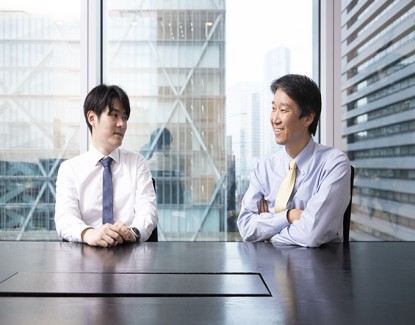Market Commentary and Fund Performance
The Portfolio Managers of Tokyo-based SPARX Asset Management Co., Ltd., sub-advisor to the Hennessy Japan Small Cap Fund, share their insights on the Japanese market, Fund performance and their outlook for Japanese stocks.
-
 Tadahiro Fujimura, CFA, CMAPortfolio Manager
Tadahiro Fujimura, CFA, CMAPortfolio Manager -
 Takenari Okumura, CMAPortfolio Manager
Takenari Okumura, CMAPortfolio Manager
Performance data quoted represents past performance; past performance does not guarantee future results. The investment return and principal value of an investment will fluctuate so that an investor’s shares, when redeemed, may be worth more or less than their original cost. Current performance of the fund may be lower or higher than the performance quoted. Performance data current to the most recent month end, and standardized performance can be obtained by viewing the fact sheet or by clicking here.
Market Highlights
In September 2025, Japan’s equity market posted solid gains. The TOPIX Index rose 2.38% month-over-month.
During the first half of the month, sentiment was weighed down by the announcement of a new to artificial intelligence (AI) chip by Alibaba Group Holding, which heightened concerns over the intensifying U.S.-China tech rivalry. This led to weakness in U.S. AI-related equities and a corresponding decline in Japanese high-tech stocks. However, market sentiment improved following the signing of a U.S. presidential executive order by President Trump, which included provisions for reducing auto tariffs between Japan and the U.S., providing a tailwind for Japanese equities.
Mid-month, weaker-than-expected U.S. employment data raised expectations for further monetary easing by the Federal Reserve (Fed). Domestically, Prime Minister Shigeru Ishiba’s resignation announcement sparked optimism around potential new policy initiatives under the next administration. These developments supported a broad-based rally in Japanese equities, with semiconductor and AI-related stocks leading the gains in U.S. equity market. Investor appetite extended to other sectors, driving both the Nikkei and TOPIX to new highs and sustaining upward momentum.
In the latter half of the month, the Federal Open Market Committee (FOMC) resumed rate cuts and signaled continued easing through year-end. Meanwhile, the Bank of Japan (BOJ) held rates steady, but two Policy Board members proposed a rate hike, increasing market expectations for a potential hike in October. Additionally, the BOJ’s decision to begin unwinding its ETF holdings triggered a temporary market correction. However, the sell-off was short-lived, and the market quickly regained composure, demonstrating underlying resilience.
Toward month-end, strong U.S. economic data tempered expectations for aggressive rate cuts, leading to a pullback in U.S. equities. This, combined with caution ahead of the Liberal Democratic Party (LDP) leadership election, contributed to a softer tone in Japanese equities. Nonetheless, the market closed the month significantly higher compared to the previous month-end.
The Fund’s Performance
As a result, the Fund returned 3.47% (HJSIX), outperforming its benchmark, the Russell/Nomura Small Cap™ Index, which returned 1.31%.
This month, stocks that positively contributed to the Fund’s performance included Takashimaya Company, Limited, Maeda Kosen Co., Ltd., and Penta-Ocean Construction Co., Ltd. Takashimaya’s stock price rose as the year-on-year slowdown in inbound consumption, which had persisted since early spring, ran its course, according to the company’s monthly sales disclosures. In addition, perceived undervaluation relative to asset levels appears to have attracted investor interest. While Maeda Kosen had no material news, its stock price experienced a period of correction following the previous quarterly earnings release, which seems to have highlighted the stock’s valuation appeal to investors. Despite the absence of company-specific news, Penta-Ocean Construction’s solid performance in the prior quarter served as a positive catalyst, prompting multiple sell-side analysts to raise their target prices. This may have contributed to positive price action during the period.
Meanwhile, stocks that negatively impacted the Fund’s performance included Raksul Inc., Gakujo Co., Ltd., and Aeon Fantasy Co., LTD. Raksul announced its full-year results, and although earnings growth continues, the stock price declined as the company’s plan did not meet market expectations. Gakujo announced its quarterly earnings and revised its full-year plan downward due to sluggish growth in its Re Shukatsu Campus (job-hunting information site) and events, which was likely met with a negative reaction. Aeon Fantasy’s monthly sales remain solid, but profit-taking selling seems to have prevailed, likely because its stock price had risen since the previous quarterly earnings announcement.
From an investment perspective, we continued to add to existing positions while selling stocks that had appreciated and appeared less undervalued. Additionally, we initiated new investments in companies such as a materials-related company, where we determined that the recent share price decline had enhanced its investment attractiveness, despite continued earnings stagnation.
Despite geopolitical risks, the Japanese stock market has remained resilient, supported by factors such as expectations for U.S. interest rate cuts, reduced U.S. tariff risks, prospects for a Japanese economic recovery, and anticipated expansionary fiscal policy following the change in government. While expectations for fiscal expansion under the new administration are closely linked to concerns about fiscal deterioration and should not be overly optimistic, we believe that the recovery of the Japanese economy and the transformation of Japanese companies in preparation for an inflationary era are progressing irreversibly. Although each individual company faces unique circumstances, such as its business environment, financial position, and management’s decision-making speed, bottom-up research conducted daily allows us to observe tangible progress in corporate mindset transformation. We will continue to strive to generate medium-to-long-term returns by identifying compelling investment opportunities.
As mentioned in our previous commentaries, we continue to research investment candidates with a particular focus on corporate governance reform. While large companies have actively worked to enhance their corporate governance, the degree of progress varies amoung companies in the small- and mid-cap market. We believe many companies still have substantial room for improvement, which could present investment opportunities. Among these, we have recently started investing in NOK Corporation.
NOK experienced a prolonged period of stagnation due to structural shifts in the market environment since the late 2010s. However, the company is now beginning to emerge from this downturn. We initiated the investment based on expectations of an improved external environment, the realization of business growth opportunities, and changes in financial strategy following a management reshuffle.
NOK is a leading manufacturer of automotive sealing materials and flexible printed circuit boards (FPCs) for smartphones. In the 2010s, both businesses enjoyed high profitability and were highly valued by the stock market. However, the automotive sealing business has been affected by the decline in production volumes of Japanese automakers, and the FPC business has experienced prolonged stagnation due to the loss of market share with the smartphone manufacturer to which it supplied exclusively. The FPC segment, in particular, was forced to close facilities and continued to record significant losses. Although impairment-related losses have run their course, the anticipated shift to electric vehicles (EVs) has yet to materialize as expected. Performance remains subdued, and the stock continues to trade at a depressed valuation.
We focused on three key points. First, there is an opportunity for improved profitability through a better external environment for the sealing business and internal reforms. Recently, demand for HEVs (hybrid electric vehicles) has been expanding from the perspectives of reducing environmental impact and practicality. Compared to internal combustion engine (ICE) vehicles, parts sales per vehicle for BEVs (battery electric vehicles) decline by 10-20%, whereas parts sales for HEVs increase by about 20%. Therefore, the expansion of HEV demand is a tailwind for the company. Additionally, price revisions to address rising raw material and labor costs, as well as withdrawals from unprofitable businesses, have not progressed sufficiently, leaving significant room for negotiation with automakers. Moreover, the reorganization of the sealing business, which was previously considered a protected area, may advance following the change in top management.
Second, there is an improvement in profitability and growth opportunities in the FPC business. After a decline in market share for smartphones, the company continued to downsize its operations, but the closures have now largely been completed, and the business achieved profitability in the fiscal year ending March 2025. Adoption by Japanese automakers, which had been delayed, has also begun, finally creating a situation where growth can be expected. Furthermore, advances in automated processing are accelerating the shift from wire harnesses to FPCs, raising expectations for further adoption expansion going forward.
Third, there is a possibility of a shift in capital policy. NOK holds ample cash and policy shareholdings on its balance sheet, and we believe there is significant room for improving capital efficiency. Although the company’s capital policy has been difficult to predict from the outside until now, the change of CFO earlier this year has increased the likelihood of a strategic shift.
Even if none of these materialize in the short term, the company’s shares are trading at a discounted level with a price-to-book ratio below 0.8 and a current dividend yield exceeding 4%. While downside risk is limited, we believe that there is substantial room for revaluation if corporate reforms and business growth progress, making this an attractive investment opportunity over the medium to long term.
Click here for Fund Holdings.
- In this article:
- Japan
- Japan Small Cap Fund
You might also like
-
 Portfolio Perspective
Portfolio Perspective
Japan Small Cap FundA Focus on Japanese Small-Caps Making Big Corporate Improvements
 Takenari Okumura, CMAPortfolio Manager
Takenari Okumura, CMAPortfolio Manager Tadahiro Fujimura, CFA, CMAPortfolio ManagerRead the Commentary
Tadahiro Fujimura, CFA, CMAPortfolio ManagerRead the CommentaryThe Portfolio Managers discuss their view of the Japanese small-cap corporate landscape amid many shifting factors, including a new Prime Minister, finalized tariff situation, currency volatility, and attractive valuation environment.
-
 Portfolio Perspective
Portfolio Perspective
Japan FundCompelling Japanese Opportunities Amid Attractive Valuations
 Masakazu Takeda, CFA, CMAPortfolio Manager
Masakazu Takeda, CFA, CMAPortfolio Manager Angus Lee, CFAPortfolio ManagerRead the Commentary
Angus Lee, CFAPortfolio ManagerRead the CommentaryThe Hennessy Japan Fund Portfolio Managers highlight the effect of the new Prime Minister on the economy and market and how holdings were affected by the final trade agreement. They also discuss currency volatility, valuations, and the most compelling opportunities as we end 2025.
-
 Investment Idea
Investment IdeaCompelling Valuations in Japan
 Masakazu Takeda, CFA, CMAPortfolio Manager
Masakazu Takeda, CFA, CMAPortfolio Manager Angus Lee, CFAPortfolio Manager
Angus Lee, CFAPortfolio Manager Tadahiro Fujimura, CFA, CMAPortfolio Manager
Tadahiro Fujimura, CFA, CMAPortfolio Manager Takenari Okumura, CMAPortfolio ManagerRead the Investment Idea
Takenari Okumura, CMAPortfolio ManagerRead the Investment IdeaJapanese equities are currently trading at compelling valuation levels compared to other developed equity markets around the world and relative to their own historical averages. We believe the Japanese market deserves a closer look.
